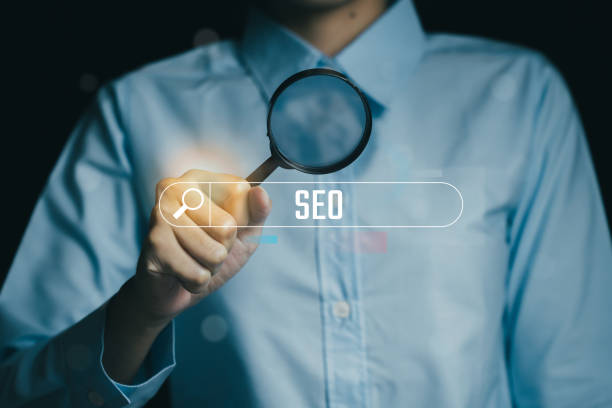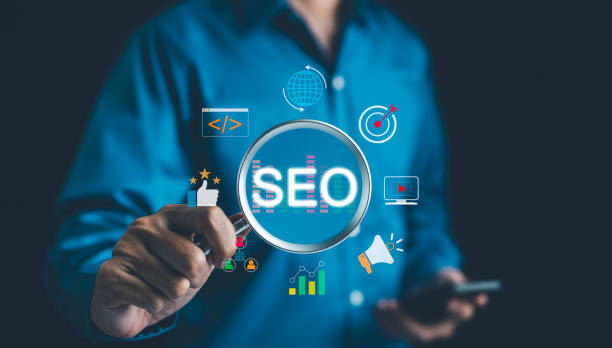Introduction to SEO and its Importance

In today’s highly competitive world, online presence is just the first step.
What distinguishes you from competitors and directs targeted traffic to your website is #Search_Engine_Optimization, or #SEO for short.
SEO is a process that helps websites gain a better position in the organic search results of engines like Google. This means increasing visibility and attracting users who are looking for your products or services.
The importance of SEO stems from the massive volume of daily user searches and its vital role in purchasing decisions or information acquisition.
A website with a high search ranking gains more credibility and significantly increases its click-through rate.
This educational field is constantly changing, as search engine algorithms are regularly updated.
Without SEO, even the best content might remain in obscurity and never reach its target audience.
Investing in SEO is a long-term strategy that brings sustainable and significant returns and is vital for any online business.
How much does losing business leads due to an unprofessional website cost you? Solve this problem forever with professional corporate website design by Rasawab!
✅ Increased credibility and trust of potential customers
✅ Easier attraction of new business leads
⚡ Get a free consultation now!
Types of SEO and its Strategies

On-Page SEO refers to all actions taken within your website to improve its ranking, such as optimizing keywords, titles, meta descriptions, URL structure, and content.
Producing thought-provoking and valuable content that addresses user needs is an inseparable part of On-Page SEO.
In contrast, Off-Page SEO refers to activities outside your website that increase its credibility and authority, such as building high-quality backlinks from reputable sites and engaging in social media activities.
This section requires a specialized and strong communication approach.
Finally, Technical SEO involves improving the technical aspects of a website so that search engines can easily crawl, index, and rank it.
This includes site loading speed, responsiveness, structured data (Schema Markup), and SSL security.
Each of these sections is essential for a comprehensive SEO strategy and must work in harmony with each other.
Keyword Research, the Backbone of SEO

Keyword research is the process of discovering the phrases users enter into search engines to find specific information, products, or services.
This stage is the foundation and backbone of any successful SEO campaign.
Without a proper understanding of the keywords your audience uses, all your efforts in content creation and optimization may be fruitless.
Various tools are available for keyword research, helping you assess search volume, competition, and keyword relevance.
The goal is not only to find popular keywords but also to discover long-tail keywords that are less competitive and more targeted.
A specialized strategy in keyword research involves analyzing the User Intent behind each search query.
Is the user looking for information (informational search), intending to buy (transactional search), or looking for a specific website (navigational search)? Understanding these distinctions allows you to produce precise and relevant content.
This process not only helps in creating useful content but also provides guidance for your site’s structure and page hierarchy.
For example, if the keyword “men’s sports shoes purchase” has a high search volume, you should create a dedicated page for this product.
In the following, a table of keyword types and their characteristics is provided:
| Keyword Type | Characteristics | Example |
|---|---|---|
| Short-Tail Keywords | High competition, high search volume, unclear intent | “shoes” |
| Long-Tail Keywords | Less competition, medium search volume, specific intent | “best men’s sports shoes for running” |
| Branded Keywords | Specific to a brand, loyal traffic | “Adidas shoes model X” |
| Informational Keywords | Questions and answers, knowledge acquisition | “how to wash sports shoes” |
Choosing appropriate keywords requires a precise analytical approach to the market and competitors to ensure your content is correctly targeted.
This part of SEO is an ongoing process and should be updated periodically.
Content Optimization for Search Engines

After keyword research, the next step is to create content that is not only useful and engaging for users but also optimized for search engines.
This means naturally integrating keywords into the text, headings, subheadings, and meta descriptions.
High-quality and comprehensive content is the cornerstone of SEO success.
It should answer users’ questions, create added value, and keep the audience engaged.
Using an appropriate structure, including short paragraphs, bulleted lists, and relevant images, can enhance content readability.
Explanatory and guidance content can help users understand complex topics.
Furthermore, you should regularly update your content to ensure it remains relevant and fresh.
Adding news or analytical content related to your industry can increase site credibility and attract more traffic.
The ultimate goal is to create an excellent user experience, as search engines increasingly focus on user satisfaction.
Engaging content can also increase user retention rates and send positive signals to search engines.
Each page of your website should have a clear SEO objective and focus on one or more target keywords to maximize its SEO power.
Are you worried that your company’s outdated website might drive new customers away? Rasawab solves this problem with modern and efficient corporate website design.
✅ Increases your brand’s credibility.
✅ Helps attract targeted customers.
⚡ Contact Rasawab for a free consultation!
Technical SEO and its Critical Factors

Technical SEO focuses on improving the technical aspects of your website so that search engines can easily crawl and index it.
Without strong Technical SEO, even the best content might never be seen by search engines.
Site loading speed is one of the most important factors; a fast-loading site provides a better user experience and has a lower Bounce Rate.
Image compression, CSS and JavaScript code optimization, and the use of CDN (Content Delivery Network) are among the methods for increasing speed.
Website responsiveness, meaning your site is displayed correctly on various devices (mobile, tablet, desktop), is also crucial, as a large portion of searches are performed via mobile.
The HTTPS protocol, which ensures website security, is an important ranking factor.
An XML Sitemap helps search engines better understand your website’s structure, and the Robots.txt file controls which parts of the site are crawled.
URL structure optimization, prevention of duplicate content, and management of 404 errors are also part of this specialized category of SEO.
Tools like Google Search Console and Lighthouse can help you identify and resolve technical SEO issues.
Proper implementation of these factors provides essential guidance for success in SEO.
The Role of Backlinks in Increasing Site Authority

Backlinks, or inbound links from other websites to your site, are one of the most powerful ranking factors in Off-Page SEO.
Search engines regard backlinks as “votes of confidence” from other websites.
The greater the number and quality of backlinks, the higher your website’s Authority with search engines, and consequently, you will achieve a better ranking.
However, quality is more important than quantity.
A backlink from a reputable, relevant, and high-authority website is worth significantly more than several backlinks from low-quality or spammy sites.
Backlink building strategy should focus on acquiring natural and ethical links, not link buying or using black-hat techniques that can lead to Google penalties.
Producing valuable and analytical content that other sites are willing to refer to is one of the best ways to attract natural backlinks.
Thought-provoking and unique content can also create more link-building opportunities.
Digital public relations activities, collaboration with influencers, and publishing news articles in relevant media are other effective methods for backlink building.
Monitoring backlink profiles and identifying toxic links is also an important part of Off-Page SEO management.
Backlinks are a continuous and long-term process that requires patience and a specialized strategy.
SEO Tools and How to Use Them

Managing and optimizing SEO is almost impossible without using appropriate tools.
These tools help SEO specialists analyze website performance, identify problems, and discover new opportunities.
Keyword research tools like Google Keyword Planner, Ahrefs, and Semrush help you find high-volume and relevant keywords.
Site analysis tools like Google Analytics and Google Search Console provide valuable information about site traffic, user behavior, and crawling and indexing issues.
Technical SEO tools like Screaming Frog and Lighthouse help identify technical issues with the website.
For Off-Page SEO and backlink analysis, tools like Ahrefs and Moz Link Explorer are very powerful.
By providing deep analytical data, these tools allow you to adjust your strategies based on evidence.
Proper use of these tools requires educational knowledge and experience.
Many of these tools have explanatory features that make them easy to use even for beginner users.
In the following, a table of some of these tools and their uses is provided:
| Tool Name | Main Use | Key Features |
|---|---|---|
| Google Search Console | Monitoring site performance in Google searches | Crawl reports, keyword performance, security issues |
| Google Analytics | Analyzing website traffic and user behavior | Traffic sources, conversion rates, popular pages |
| Ahrefs | Keyword research, backlink and competitor analysis | Domain strength analysis, finding link-building opportunities |
| Semrush | Competitor analysis, keyword research, site health check | SEO and PPC competitor analysis, content review |
By using these tools, you can adopt a data-driven approach to improve your SEO ranking and increase your site’s visibility in search engines.
These tools play a very important guiding role in your SEO journey.
Local SEO and its Importance for Physical Businesses

Local SEO is a branch of SEO that focuses on optimizing your website for higher rankings in local search results.
This type of SEO is particularly important for businesses with physical locations (such as restaurants, stores, clinics, etc.).
When users search for “coffee shop near me” or “best restaurant in Tehran”, local SEO results are displayed.
The main tool for local SEO is Google My Business (now Google Business Profile).
Accurate completion and continuous updating of information on this platform, including name, address, phone number (NAP), business hours, images, and customer reviews, are vital for increasing visibility in local results.
Obtaining positive reviews from real customers and responding to them increases your business’s credibility and sends positive signals to Google’s algorithms.
In addition to Google My Business, ensuring NAP consistency across all online directories and websites is also important.
Optimizing local keywords in site content, creating landing pages for each branch, and acquiring backlinks from local websites are also effective in improving local SEO ranking.
This explanatory and guiding approach helps local businesses gain a larger share of the online market and attract more physical traffic.
Does your company’s website perform as befits your brand? In today’s competitive world, your website is your most important online tool. Rasawab, a specialist in professional corporate website design, helps you to:
✅ Build customer credibility and trust
✅ Convert website visitors into customers
⚡ Get a free consultation!
Data Analysis and Reporting in SEO

Success in SEO doesn’t end with strategy implementation; it requires continuous monitoring, data analysis, and regular reporting.
Without precise analysis of performance, you cannot identify the strengths and weaknesses of your SEO campaign and optimize future strategies.
Tools like Google Analytics and Google Search Console provide valuable data on organic traffic, keyword rankings, click-through rate (CTR), bounce rate, and user dwell time on the site.
Analyzing this data helps you understand how users interact with your site and which sections need improvement.
For example, if a page’s bounce rate is high, it might indicate irrelevant content or a poor user experience.
Regular reporting allows for tracking progress over time and enables you to measure the return on investment (ROI) of your SEO activities.
These reports should include Key Performance Indicators (KPIs) such as increased organic traffic, improved keyword rankings, and growth in conversions.
Providing explanatory and comprehensive reports to stakeholders increases transparency and clearly demonstrates the value of SEO.
This educational and iterative process ensures continuous optimization for achieving better SEO results.
The Future of SEO and Upcoming Trends

The world of SEO is constantly changing and evolving.
What is effective today might be obsolete tomorrow; therefore, awareness of future trends is crucial for maintaining a competitive edge.
One of the most important upcoming trends is voice search.
With the growing use of voice assistants like Siri and Google Assistant, optimizing for conversational and longer keywords has become increasingly important.
Artificial intelligence and machine learning will play a more prominent role in search engine algorithms, and high-quality content relevant to user intent will become even more valuable.
Video content and podcasts are also becoming important formats in SEO, and optimizing them for search engines (like YouTube) is essential.
User Experience (UX) will gain more importance as a key ranking factor, with a focus on Google’s Core Web Vitals.
Semantic SEO, which focuses on a complete understanding of the meaning behind words and topical connections, will be vital for ranking comprehensive and in-depth content.
Engaging and interactive content can also help increase user dwell time and reduce bounce rate.
For SEO specialists, it is essential to constantly learn and update their knowledge to keep pace with these changes and adapt their strategies for the future of SEO.
Frequently Asked Questions
| Question | Answer |
|---|---|
| What is SEO? | SEO, or Search Engine Optimization, is the process of increasing the quality and quantity of website traffic by improving the site’s ranking in organic search results of search engines like Google. |
| What are the main types of SEO? | SEO is divided into three main categories: On-Page SEO, Off-Page SEO, and Technical SEO. |
| What does On-Page SEO include? | On-Page SEO includes optimizing elements within the website, such as keywords, Title Tags, Meta Descriptions, content, URL structure, images, and internal links. |
| What is Off-Page SEO? | Off-Page SEO refers to activities outside the website that help improve its ranking, such as Backlink Building, social media marketing, and Brand Mentions. |
| What is Technical SEO? | Technical SEO involves optimizing the technical aspects of a website to help it be crawled and indexed better by search engines. This includes site speed, mobile-friendliness, site structure, Sitemaps, and the Robots.txt file. |
| What role do Keywords play in SEO? | Keywords are phrases that users enter into search engines. The correct and targeted use of relevant keywords in content and site elements helps search engines understand the topic of your page and display it for relevant searches. |
| What is a Backlink and why is it important? | A backlink, or inbound link, is a link from one website to another. Backlinks act as a “vote of confidence“ from other sites for search engines and play a significant role in site credibility and ranking improvement, especially if they come from reputable sites. |
| What impact does quality content have on SEO? | Quality, relevant, comprehensive, and unique content not only attracts and retains users but also shows search engines that your page is valuable. This helps improve ranking, reduce Bounce Rate, and increase user dwell time on the site. |
| Why is site loading speed important for SEO? | Site loading speed is an important ranking factor for Google. Faster sites offer a better user experience, have a lower bounce rate, and are preferred by search engines. |
| Is SEO a one-time process? | No, SEO is an ongoing and long-term process. Search engine algorithms are constantly changing, competition is increasing, and site content also needs updating. Therefore, SEO requires continuous monitoring, analysis, and optimization. |
And other services of Rasawab Advertising Agency in the field of advertising
Smart Marketplace: A fast and efficient solution for increasing website traffic, focusing on intelligent data analysis.
Smart UI/UX: Professional optimization for campaign management using real data.
Smart Website Development: A professional solution for customer acquisition, focusing on using real data.
Smart Link Building: An effective tool for increasing sales by optimizing key pages.
Smart Marketplace: A professional solution for user interaction, focusing on optimizing key pages.
And more than hundreds of other services in the field of internet advertising, advertising consultation, and organizational solutions
Internet Advertising | Advertising Strategy | Advertorials
Sources
Comprehensive SEO GuideSEO Tips 2023On-Page SEO TrainingOff-Page SEO and Backlinks
For your business to leap forward in the digital space, Rasawab Afarin Digital Marketing Agency paves your path to success with services such as custom website design, Search Engine Optimization (SEO), and professional social media management.
📍 Tehran, Mirdamad Street, next to Central Bank, Southern Kazeroun Alley, Ramin Alley, No. 6



